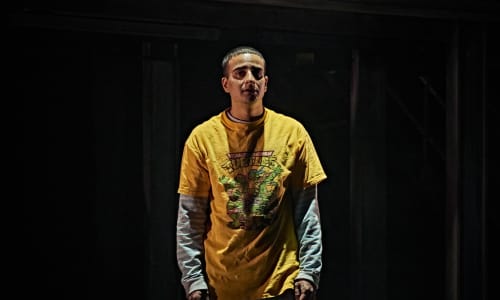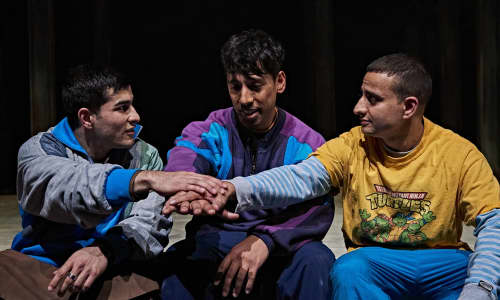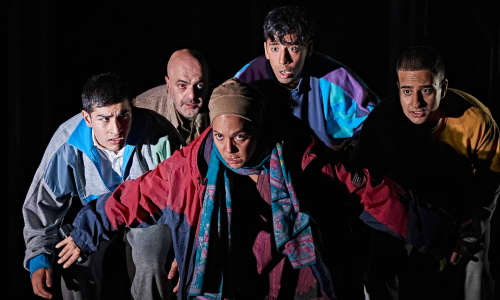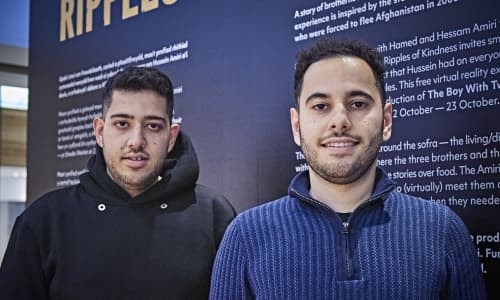Actor Farshid Rokey, who returns to play Hamed Amiri in The Boy with Two Hearts this autumn, reflects on the formula for making theatre more inclusive.
The play – based on the original book by Hamed Amiri – tells the true story of the Amiri family, whose lives changed forever when they were forced to flee Afghanistan in 2000 and eventually found refuge in Cardiff.

Growing up I always looked at theatres as buildings that I was never good enough to go into.
For me it was symbolic of a class system that I was not part of. A class system that was better than what me and my family were considered to be.
In 2010 I got my first job in theatre, and it was the first time I’d ever stepped into a theatre. I felt like a fish out of water.
On our first preview, I looked out into the audience and thought I wouldn’t fit in sitting amongst those people and whenever I tried to as a theatregoer, I always felt I was being judged or felt less deserving to be there.
As years have gone on, I have heard of the ‘idea’ of inclusion and how important it is now to make theatre accessible. If I’m honest, I felt it was just a lot of talk and virtue signalling amongst people who said they cared about creating change but never really cared.
The rhetoric of 'we must keep having these difficult conversations' replaced any form of action coming into fruition to create change. A sort of excuse to say ‘yep, I’m listening’ but not really doing anything about it.
As years passed by doing successful theatre productions, I still never saw any change to the demographic of theatregoers. I developed the notion that this ‘idea’ of theatre being ‘inclusive’ was a fairy tale and that theatres use this line to help their funding.
That they really didn’t want change. They may say they do to make themselves and their theatre look good. But they didn’t really want it. And this thinking was reinforced on multiple occasions.

I worked in a rehearsal room with others who looked like me, who spoke like me
During rehearsals of The Boy with Two Hearts, I worked in a rehearsal room with others who looked like me, who spoke like me and reflected a side of the multicultural UK that we live in.
I thought to myself, this is different, interesting, and exciting. Who will come to see it? I couldn’t answer this question because for the first time, I just didn't know.
I walked out on the first show to start the play with my opening line, and I paused. I took in the front row and couldn’t believe what I saw. A woman in a hijab with three other women in hijabs.
I looked to the right and saw a group of boys who looked like me smiling back as to say we’re with you and just happy to see someone who looked like them to be up on that stage doing this job.
Is this the play that can set the start of change?
I took this in and looked at my shoes. Said to myself “have we done it? Is this the play that can set the start of change?” My answer was it’s probably just a lucky night. But it wasn’t.
Every show I looked out into the audience and was taken back. The truth of the outside world has made its way to the inside world of the theatre. I couldn’t believe my luck. This is what change looks like and the future of theatre.

How did this come about? How did we get it right on this occasion? What is the formula to repeat this success, that others can learn from?
First, it starts with the writing. The story. Telling a universal story that crosses boundaries of race, religion, socio-economic status.
The story has to have a core a theme that is relatable. For The Boy with Two Hearts, it was the universal core of family and hope. No matter who you are in the audience this universal core strikes you.
Secondly, and in my opinion most importantly, it comes down to casting. Chemistry is something you can’t fake, the company either have it or don’t.
Having worked on other plays to do with Afghanistan, The Boy with Two Hearts, for me, has to be the most authentic and chemistry-driven show.
You had Afghan writers, actors and musicians all in the same room, all responding to a collective consciousness/subconscious that they lived.

The actors for me brought so much of their own life experience and truth to make this production relevant to a bigger and diverse audience. The work and detail the actors put in moment to moment brought the story to life.
I think this stems from the actors knowing their responsibility of being representatives of this very culture. The truthful casting of this culture helped set the temperature on and off stage. The audience felt this on a deep level.
Lastly, I think it’s worth noting the marketing work that was pushed by Wales Millennium Centre but also Hamed and Hessam Amiri.
They really were on the frontline pushing audiences of a diverse nature to come and see this play. Having two individuals like that on the frontline really made a difference.

I had this belief for years that this goal of inclusion was out of reach and not possible. I feel The Boy with Two Hearts is the story that can ignite the flame to make this goal ever more reachable.
I’ve seen it, the cast have seen it and the building has seen it. To quote Emma Evans (Head of Productions, Wales Millennium Centre) “It’s the most diverse audience we have ever had.”
The Boy with Two Hearts
12 – 17 September, Dance House, Cardiff
Sold Out
1 October – 12 November, National Theatre, London
Find tickets
